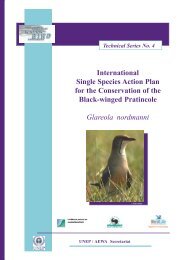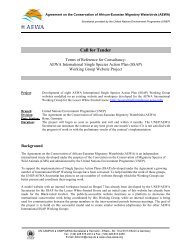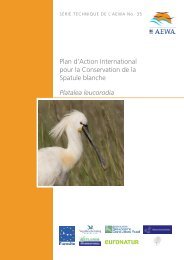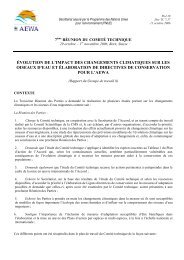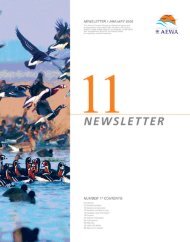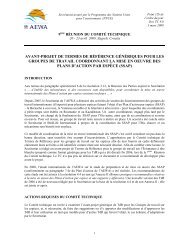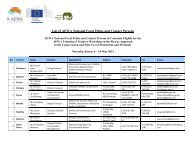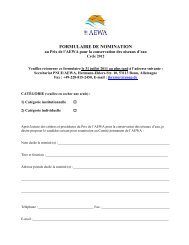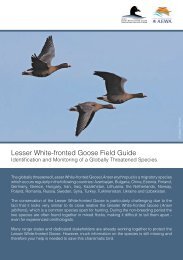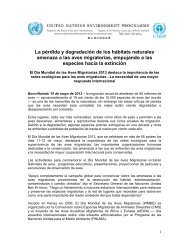International Single Species Action Plan for the ... - AEWA
International Single Species Action Plan for the ... - AEWA
International Single Species Action Plan for the ... - AEWA
You also want an ePaper? Increase the reach of your titles
YUMPU automatically turns print PDFs into web optimized ePapers that Google loves.
<strong>AEWA</strong> Technical Series No. 36<br />
birds from Russia had been received.<br />
In November 2005, <strong>the</strong> Scientific Council of <strong>the</strong> Convention on Migratory <strong>Species</strong> concluded,<br />
as part of its wider recommendation on Lesser White-fronted Geese (see pages 34–35 and<br />
Annex 9a), that: “For <strong>the</strong> present, we do not support <strong>the</strong> introduction of Lesser Whitefronts<br />
into flyways where <strong>the</strong>y do not occur naturally. We have borne in mind <strong>the</strong> powerful<br />
argument concerning <strong>the</strong> improved safety of birds in <strong>the</strong>se flyways, as well as practical<br />
considerations, such as current proposals that could quickly be put into effect. However, we<br />
consider that modifying <strong>the</strong> natural behaviour of Lesser Whitefronts in this respect, as well as<br />
unknown ecological effects in <strong>the</strong> chosen new flyways, and o<strong>the</strong>r such considerations, make<br />
this technique inappropriate until such time as it may become essential, particularly when<br />
major disruption or destruction occurs of key components of <strong>the</strong> natural flyways. We do not<br />
believe that to be <strong>the</strong> case at present.”<br />
Following consultations in 2006 and 2007 between <strong>the</strong> German government, Aktion<br />
Zwerggans, <strong>the</strong> Fennoscandian range states and <strong>the</strong> <strong>AEWA</strong> Secretariat, it was agreed that<br />
implementation of <strong>the</strong> Aktion Zwerggans experimental pilot project would be postponed by<br />
three years to enable sufficient stock to be built up derived entirely from wild-caught Russian<br />
birds, or to seek international acceptance, in particular of <strong>the</strong> results of a genetic analysis of<br />
captive and wild LWfG conducted in <strong>the</strong> framework of <strong>the</strong> project (<strong>AEWA</strong> 2007; Annex 10);<br />
see also page 36. In May 2008 <strong>the</strong> first meeting of <strong>the</strong> Committee <strong>for</strong> Captive Breeding,<br />
Reintroduction and Supplementation of LWfG in Fennoscandia passed a joint<br />
recommendation underlining that proof of <strong>the</strong> purity of captive German-bred birds is still not<br />
given and would fur<strong>the</strong>rmore need to be assured be<strong>for</strong>e any use of such birds could be<br />
endorsed. The Use of wild-caught Russian birds was confirmed as <strong>the</strong> better way <strong>for</strong>ward<br />
(Report from <strong>the</strong> 1 st Meeting of <strong>the</strong> Committee <strong>for</strong> Captive Breeding, Reintroduction and<br />
Supplementation of Lesser White-fronted Geese in Fennoscandia).<br />
1.4 Distribution throughout <strong>the</strong> Annual Cycle<br />
The three wild subpopulations (see section 1.2) and <strong>the</strong> supplemented/reintroduced Swedish<br />
population have differing migration routes and wintering grounds, though <strong>the</strong>re is known to<br />
be partial overlap in <strong>the</strong> case of <strong>the</strong> Fennoscandian and Western main populations. The main<br />
flyways are indicated in Figure 1.<br />
Fennoscandian population<br />
Satellite tracking has shown that non-breeding birds from <strong>the</strong> small Fennoscandian population<br />
undertake an autumn migration eastwards to <strong>the</strong> Kanin Peninsula, Kolgujev Island (and even<br />
as far as <strong>the</strong> Taimyr Peninsula) in nor<strong>the</strong>rn Russia (Aarvak & Øien 2003). Successful breeders<br />
moult on <strong>the</strong> breeding grounds, but <strong>the</strong>n also undertake a migration eastwards to <strong>the</strong> Kanin<br />
Peninsula. There is subsequently a migratory divide, with some birds heading south-west,<br />
presumably through western Russia (Lake Ladoga region), western Estonia, Poland and<br />
eastern Germany, and <strong>the</strong>n south-east, via a major staging area in Hungary (Hortobágy) and<br />
Greece (Lake Kerkini) to wintering grounds in north-east Greece (Evros Delta), adjacent to<br />
<strong>the</strong> Turkish border. There is also evidence that <strong>the</strong>se birds visit <strong>the</strong> Turkish side of <strong>the</strong> Evros<br />
Delta and/or o<strong>the</strong>r sites in westernmost Turkey during <strong>the</strong> winter. O<strong>the</strong>r birds migrate<br />
eastwards, crossing <strong>the</strong> Ural mountains, and <strong>the</strong>n turning south through <strong>the</strong> Ob valley to<br />
north-west Kazakhstan and onwards to presumed Black Sea and Caspian Sea wintering areas,<br />
thought to be shared with <strong>the</strong> Western main population (Lorentsen et al. 1998; Aarvak & Øien<br />
2003). The most recent evidence from satellite tracking during 2006/2007 shows that all three<br />
Fennoscandian individuals that have been tracked this far south have undertaken an<br />
astonishing loop migration to <strong>the</strong> Greek wintering grounds via <strong>the</strong> Ob Valley, north-west<br />
Kazakhstan and <strong>the</strong> Black Sea, returning north through Hungary and <strong>the</strong> Baltic (LIFE Nature<br />
project 2005–2008 Conservation of <strong>the</strong> Lesser White-fronted Goose on European migration<br />
route – see Figure 4).<br />
<strong>International</strong> <strong>Single</strong> <strong>Species</strong> <strong>Action</strong> <strong>Plan</strong> <strong>for</strong> <strong>the</strong> Conservation of <strong>the</strong> Lesser White-fronted Goose 15



